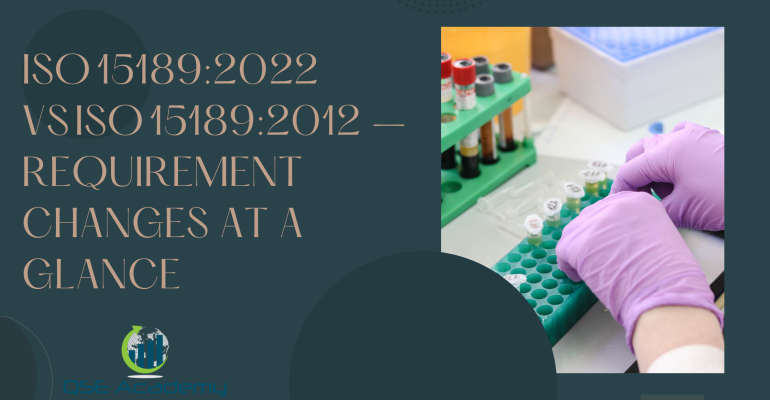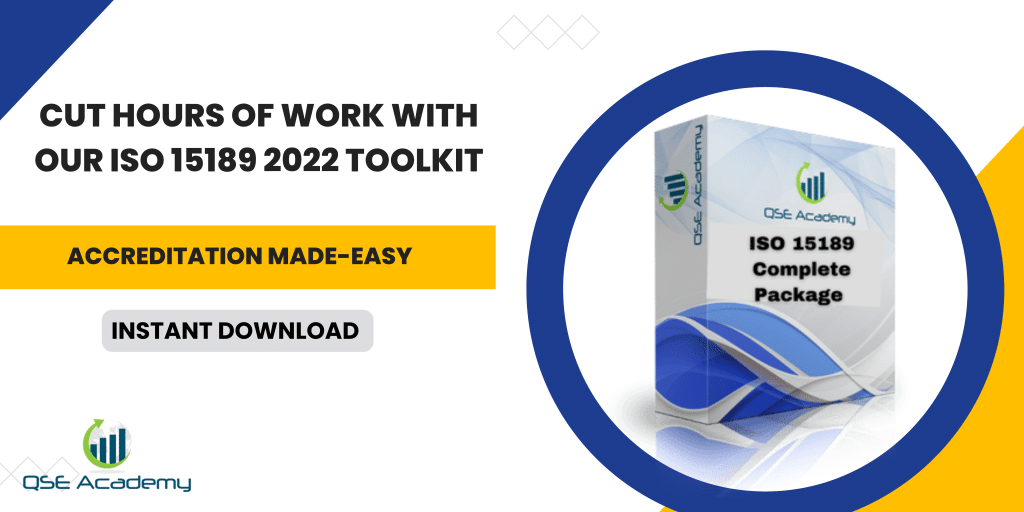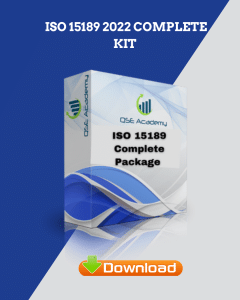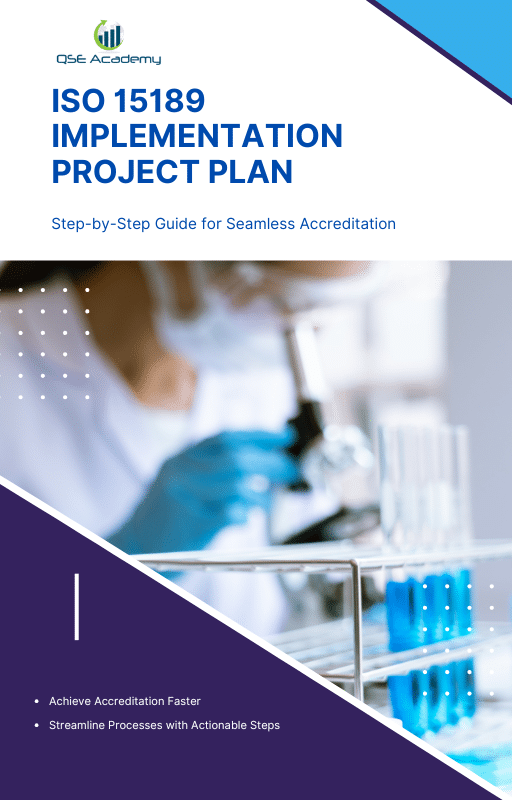ISO 15189:2022 vs ISO 15189:2012 – Requirement Changes at a Glance
Last Updated on October 22, 2025 by Hafsa J.
What Changed and Why It Matters
When ISO 15189:2022 was released, many labs felt the same mix of curiosity and worry: How different is it really from 2012?
I’ve helped several clinical labs move through this transition, and here’s what I noticed—those that understood the intent behind the changes adapted faster and with fewer audit findings.
The 2022 version isn’t just a cosmetic update. It reshapes how laboratories prove competence, manage risk, and protect patient data.
It moves away from rigid procedures and focuses on outcomes—on whether your lab’s system actually supports reliable, patient-safe results.
By the end of this guide, you’ll know exactly:
-
What changed between 2012 and 2022
-
Why those changes matter for your day-to-day operations
-
How to realign your system without starting from scratch
Why the 2022 Update Was Needed
Over the last decade, medical laboratories have transformed more than most people realize.
Automation, digital result transmission, and integrated information systems are now standard. Yet, ISO 15189:2012 was written in a time when most labs still printed reports and logged data manually.
That’s why ISO released the 2022 revision—it had to catch up with how modern labs actually work.
This version places less emphasis on documentation volume and more on evidence of competence and consistency. It also aligns with the structure of ISO/IEC 17025 and ISO 9001, making integration smoother for labs that already manage multiple systems.
In my experience, the update also clears a lot of grey areas.
For example, labs always asked, “How much documentation is enough?”
Now the standard guides you to apply risk-based judgment instead of chasing paperwork for its own sake.
Pro Tip: Don’t view the new version as “more work.” It’s actually more flexible. You can adapt your procedures to fit your lab’s size and complexity—something that wasn’t always clear before.
Structural Comparison – Clause-by-Clause Breakdown
One of the first things labs notice when they open ISO 15189:2022 is that the structure looks completely different.
The 2012 version was divided into two main parts: Management Requirements (Clause 4) and Technical Requirements (Clause 5).
Now, those sections are reorganized into Clauses 5 to 8, following the same layout used in ISO/IEC 17025 and ISO 9001.
This change isn’t just about renumbering—it’s about clarity.
It helps labs and accreditation bodies speak the same language across different standards.
Here’s a quick side-by-side comparison to make it easier to see what’s new:
| ISO 15189:2012 Clauses | ISO 15189:2022 Clauses | Key Focus in 2022 |
|---|---|---|
| 4 – Management Requirements | 8 – Management System Requirements | Incorporates risk and opportunity management; greater flexibility |
| 5 – Technical Requirements | 6 – Resource Requirements & 7 – Process Requirements | Distinct focus on competence, impartiality, and process control |
| — | 5 – Structural Requirements | Adds governance, authority, and impartiality principles similar to ISO/IEC 17025 |
This new layout makes it easier to align your quality system if you’re also accredited under another ISO standard.
And it’s far simpler to assign ownership within the lab—management can oversee Clause 8, while section heads can handle Clauses 6 and 7.
Pro Tip: Use a clause correlation matrix to update your documentation.
It’s one of the quickest ways to spot overlaps, redundancies, and missing links when migrating from 2012 to 2022.
Common Mistake: Some labs assume they can simply “rename” clauses in their manuals and be done. Unfortunately, that doesn’t work—the intent and evidence requirements have changed. Take time to review the context behind each clause, not just the numbering.
Major Requirement Changes – What’s New in ISO 15189:2022
Now that you know how the structure shifted, let’s look at what actually changed inside.
The 2022 version doesn’t just shuffle clauses—it redefines how labs prove competence and control risk.
Here are the biggest updates you’ll notice:
1. Risk-Based Management System
The heart of the new edition is risk-based thinking.
Labs now need to identify, assess, and manage risks that could affect quality or patient safety.
Instead of checking whether a procedure exists, assessors now look for proof that your lab understands why each control matters.
Pro Tip: Use your existing incident logs and quality indicators as inputs for your risk register. You already have most of the data—you just need to formalize how you analyze it.
2. Competence and Impartiality Emphasis
Personnel competence isn’t just about qualifications anymore. The 2022 standard requires ongoing performance evaluation, not just initial training.
It also introduces stronger requirements for impartiality—especially in labs tied to clinical decision-making or commercial interests.
Example: One lab I supported had to document how conflicts of interest were avoided during result validation. That simple clarification helped them pass their transition audit smoothly.
3. Information Management and Data Integrity
This is a new area entirely. Labs must now validate electronic systems and ensure data integrity from sample entry to result release.
Your LIS or LIMS isn’t just a convenience—it’s now part of your accredited quality system.
Common Mistake: Updating technical procedures but ignoring how electronic approvals or backups are handled. Assessors will ask for that evidence.
4. Focus on Patient Safety and Confidentiality
Patient-focused outcomes are front and center.
Labs must show how their processes minimize risks to patient safety and protect confidentiality—especially when using electronic or cloud-based systems.
Pro Tip: Document how your lab ensures confidentiality across every touchpoint—sample collection, reporting, and communication. This often becomes an easy “win” in audits when properly mapped.
In short, the 2022 version moves from compliance-driven to competence-driven.
It’s not about what you have documented; it’s about how effectively your system protects accuracy, integrity, and patient trust.
Implementation Insights – How to Transition Smoothly
Shifting from ISO 15189:2012 to 2022 can feel overwhelming at first glance, but once you break it into clear steps, it’s much more manageable.
In my experience, labs that plan their transition like a small project—complete with deadlines and champions—get accredited faster and with fewer corrective actions.
Here’s a simple, proven approach you can follow:
Step 1. Conduct a Gap Analysis
Start by comparing your existing system against the new clauses.
Use a clause correlation matrix—it’s the easiest way to spot where you’re already compliant and where you need updates.
Pro Tip: Don’t overcomplicate it. Focus first on areas like risk management, impartiality, and information integrity—these are the biggest sources of new evidence.
Step 2. Update Your Documentation
Review procedures, policies, and forms to align with the new structure.
Avoid rewriting everything. Instead, cross-reference existing documents to the new clause numbers.
Example: One of our clients simply added a “Clause 8 Mapping” column to their document list, showing how each procedure met new requirements. It satisfied the auditor and saved hours of rewriting.
Step 3. Train and Engage Your Team
The 2022 version places strong emphasis on competence and impartiality.
Your staff needs to understand the intent behind the changes—not just the words.
Hold short, role-based training sessions where each team learns how their daily work ties into the revised standard.
Common Mistake: Sending everyone to a one-size-fits-all webinar. People tune out. Tailor training to what they actually do.
Step 4. Validate Electronic Systems
If you use a Laboratory Information System (LIS), confirm its validation, access control, and data backup processes.
Auditors now expect clear proof that your electronic systems maintain data integrity.
Pro Tip: Treat your LIS validation like equipment calibration—it’s a form of verification, not an IT checklist.
Step 5. Conduct Internal Audits and a Mock Assessment
Before your next accreditation visit, schedule a mock audit based on the 2022 clauses.
It helps your team get comfortable with the new structure and gives you time to fix weak spots.
Example: A midsize hospital lab I worked with ran a two-day internal “transition audit.” They uncovered missing impartiality records early, saving them from a nonconformity later.
Smooth transitions aren’t about perfection—they’re about preparation.
By taking a structured, step-by-step approach, you’ll demonstrate control, awareness, and readiness long before your assessor steps through the door.
Impact on Accreditation – What Assessors Will Expect
If you’re preparing for your first surveillance or transition audit under ISO 15189:2022, here’s the truth: assessors aren’t just checking if you “know” the new clauses—they’re checking if your team can live them.
The focus has shifted from paperwork to performance evidence.
Expect auditors to spend more time interviewing staff, reviewing risk records, and observing how competence is managed in real time.
What Assessors Will Pay More Attention To
-
Competence Validation – They’ll ask how you assess ongoing competence, not just initial training.
-
They may interview staff performing complex or high-risk tests.
-
Evidence they’ll look for: training matrices, observation checklists, error reviews.
-
-
Impartiality Controls – Assessors now expect explicit documentation of how you identify and manage conflicts of interest.
-
For example, a senior technologist validating results for a department they also supervise may need a documented impartiality safeguard.
-
-
Risk and Opportunity Records – Be prepared to show how your lab identifies, evaluates, and acts on risks.
-
The days of “we didn’t have any risks this month” are over.
-
-
Information Management Evidence – Auditors will review LIS validation reports, backup schedules, and data access logs.
Pro Tip:
Update your management review agenda to include:
-
Risk and opportunity updates
-
Information management issues
-
Competence review outcomes
Auditors love seeing that these elements are integrated—not treated as separate boxes to tick.
Common Mistake:
Some labs assume the new edition makes audits easier. It doesn’t—it makes them more relevant.
Auditors won’t chase forms; they’ll ask, “Show me how this process ensures accurate results every time.”
When your team can confidently answer that question, you’re already demonstrating conformity.
Quick Reference Summary – ISO 15189:2022 vs 2012 at a Glance
By now, you’ve seen how the 2022 edition reshapes the entire standard—structure, intent, and mindset.
But if you need to brief your team or management quickly, here’s a simple snapshot comparing the two versions side by side.
| Area | ISO 15189:2012 | ISO 15189:2022 | Impact on Your Lab |
|---|---|---|---|
| Structure | Two sections: Management (Clause 4) and Technical (Clause 5) | Four main sections (Clauses 5–8) aligned with ISO/IEC 17025 | Easier integration and clearer clause ownership |
| Risk Management | Not explicitly required | Mandatory, integrated throughout | Promotes proactive prevention instead of reactive correction |
| Competence & Impartiality | Focused on qualifications | Ongoing competence monitoring and impartiality evidence required | Requires documented performance evaluations |
| Information Management | Limited focus on records | Full coverage of LIS validation, data integrity, and confidentiality | IT and QA now share accountability |
| Patient Safety Focus | Mentioned generally | Embedded in all processes | Direct link between quality system and patient outcomes |
| Documentation | Heavily prescriptive | Flexible, outcome-based | Allows tailoring to lab size and complexity |
This table works great in staff briefings—it helps everyone visualize the change and understand why your updates matter.
Once your team grasps these differences, they’ll see that ISO 15189:2022 isn’t harder—it’s smarter.
Pro Tip: Keep this comparison in your management review records. It helps justify why certain documents or procedures were revised during your transition.
FAQs – ISO 15189:2022 Transition & Compliance
These are the questions I hear most often from labs preparing for their transition audit.
They might be on your mind too, so let’s clear them up.
Q1: How long do we have to transition from ISO 15189:2012 to ISO 15189:2022?
Most accreditation bodies are allowing a three-year transition period, ending in December 2025.
That means your lab needs to be fully compliant by then—or risk losing accreditation under the old version.
However, some bodies (like SANAS or CAP) may move faster, so it’s best to confirm their specific schedule.
Pro Tip: Plan to transition early. Labs that wait until the final year often face bottlenecks with assessors and documentation updates.
Q2: Can ISO 15189:2022 be integrated with other standards like ISO/IEC 17025 or ISO 9001?
Absolutely.
In fact, ISO 15189:2022 was intentionally aligned with ISO/IEC 17025’s structure (Clauses 5–8).
That makes it easier for labs handling both clinical and analytical work—or those already using ISO 9001—to integrate processes and share documentation.
Example: One of our clients combined their management reviews for 9001 and 15189. It saved them hours while meeting both standards’ requirements.
Q3: What’s the best way to train staff on the new requirements?
Skip long theoretical sessions.
Short, role-based micro-trainings work best—especially when combined with case examples or mini-audits.
For instance, instead of lecturing about “risk management,” have each team identify one potential risk in their workflow and discuss how to control it.
That simple exercise not only reinforces the concept but also creates documentation you can use as audit evidence later.
Q4: Will we need to rewrite our entire Quality Manual?
Not necessarily.
You can revise and re-map your existing manual to fit the new clause structure.
The key is to show how your policies and procedures now reflect risk-based thinking and competence management.
Pro Tip: Keep a “Transition Tracker” document showing what was updated and why. Assessors appreciate transparency—it shows you’re in control of the change.
Your Next Step Toward ISO 15189:2022 Compliance
The ISO 15189:2022 revision represents more than just new clause numbers—it’s a mindset shift.
It asks labs to move from compliance for the sake of accreditation to competence for the sake of patient trust.
If there’s one thing I’ve learned helping labs through this transition, it’s this: the labs that approach the update as an opportunity to improve, not a burden, end up stronger, more efficient, and far more audit-ready.
Let’s recap the essentials:
-
ISO 15189:2022 aligns closely with ISO/IEC 17025 and ISO 9001, making integration easier.
-
Risk-based thinking replaces rigid documentation.
-
Competence, impartiality, and information integrity are now front and center.
-
Patient safety isn’t a clause—it’s the core of the standard.
If your team can demonstrate those points clearly during your next audit, you’re already ahead.
Here’s your next step:
Download or create an ISO 15189:2022 Gap Analysis Checklist and start mapping your system today.
If you need a practical, ready-to-use toolkit or guidance through the documentation updates, QSE Academy can help you streamline the transition and prepare confidently for accreditation.
Whether it’s ISO 9001, ISO 22000, or the cosmetics-focused ISO 22716, I’ve spent my career I’m not here to call myself an expert—I prefer “enthusiast” because I truly love what I do. When I’m not writing about standards, you’ll probably find me playing Piano 🎹, connecting with people, or diving into my next big project💫. I’m an engineer specialized in the food and agricultural industry
make ISO standards less intimidating and more approachable for everyone.
turning complex jargon into clear, actionable steps that businesses can actually use.
There’s something incredibly rewarding about helping people navigate food safety and quality management systems
in a way that feels simple, practical, and even enjoyable.
I have a Master’s in QHSE management and over 12 years of experience as a Quality Manager
I’ve helped more than 15 companies implement ISO 9001, ISO 22000, ISO 22716, GMP, and other standards
My clients include food producers, cosmetics manufacturers, laboratories, and service companies
I believe quality systems should be simple, useful, and efficient.













